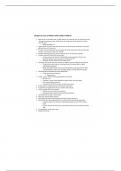Chapter 35: Care of Patient with Cardiac Problems
Right atrium tricuspid valve right ventricle pulmonic valve pulmonary artery
lungs pulmonary veins left atrium mitral valve left ventricle aortic
valve aorta
o NEED TO KNOW***
High pressure on aortic valve, left ventricle has to work harder; sometimes muscle will
get weak and can’t overcome
If I have not a lot of pressure on aortic valve, BP will be lower, fever will cause this, like
sitting in a hot tub for a long time, LOW BP
If patient with hypertension, pressure that the LV has to overcome is greater
Preload: volume that heart has to work with
o Increase amount of volume: IV fluids (bolus), blood products, thirst, renal
failure/HF, sodium super important in heart failure****
o Decrease: diuretic, trauma, urine output, burns
Afterload: what aortic valve has to pump out against; pressure body has to overcome
o Things that constrict vessels; smoking, albuterol (increase fight or flight),
hyperlipidemia (plaque)
o Things that dilate vessels: sepsis, fever (drops BP), nitrates (give this for MI to
relax blood flow to heart bc constricted), digoxin inotrope (help with pump)
PRELOAD AND AFTERLOAD ARE VERY IMPORTANT
o Things that increase afterload
Hypertension
Cardiac output: amount of blood pumped from ventricles
o SV x HR = CO
o If patient is super volume depleted and give fluids, HR comes down
o HR is compensatory response
o If patient has HR of 40, increase or hold on to volume
Stroke volume: volume with each contraction of the heart
If ventricles are unable to fill, this is a problem with preload
Cardiac output affects renal output
o Kidneys are very sensitive to perfusion
o Decreased cardiac output, decreased kidney filtration
Left sided heart is what is more severe
Take Lasix, diuretic affects preload
CHF patient will often have bad period and then improve and so on
Ejection fraction: percentage of blood in ventricles that is ejected during systole
o If ejection fraction is 75%, that is the blood pumped out with 75% of what is
given
o If I have ejection of 15%, heart is only able to pump out 15% of what it is given;
BAD
During diastole, mitral valves open
Systole, they close
, Heart failure
o Heart dysfunction that results in inadequate perfusion of tissues with blood
borne nutrients
o Think of this as pump failure
o If patient has acute MI or heart attack, they are going to have an acutely weak
heart
Thinned out muscle and increased capacity to hold volume
If I have more volume (body is trying to hold onto volume), the contractibility is not
there
Heart failure: heart has more room to take blood in but can’t get it out as efficiently
Can also have thickening of muscle, but preload is reduced
Diabetes will help deposit lipids, heart has to work harder to get rid of
75% of the time when heart failure occurs, hypertension is the cause
Acute: from MI
Chronic: progressive deterioration of muscle
Pregnancy can put person into HF
Acute: from MI or injury
Chronic: progressive deterioration of heart muscle
PND
o The fluid from throughout the day, person lays down and volume is redistributed
and absorbed, person wakes up feeling SOB and restless
First sign someone is struggling with CHF
Systolic failure
o Weak pump
Diastolic failure
o Stiff ventricle
left sided failure can back up into right
left sided heart failure (LUNGS)
o main pumping ventricle
o decreased blood through body
o backed up into lungs
o patient will complain of: SOB, auscultate crackles, sputum, weakness/fatigue,
pink frothy sputum (pulmonary edema), cough that gets worse at night (laying
down gets backed up in lungs)
o oliguria
LESS THAN 30 CC/HOUR
o If heart is not pumping well, kidney will not function well
o URINE OUPUT IS DIRECTLY RELATED TO CARDIAC OUTPUT***
o Manifestations
Cough
Fatigue
Orthopnea
Cyanosis




